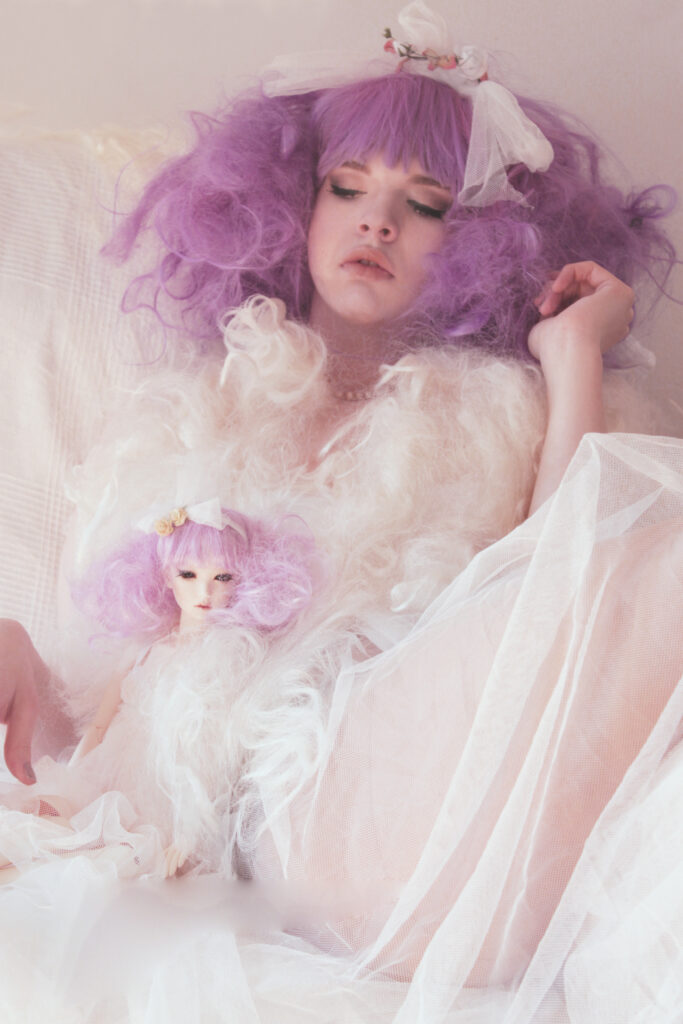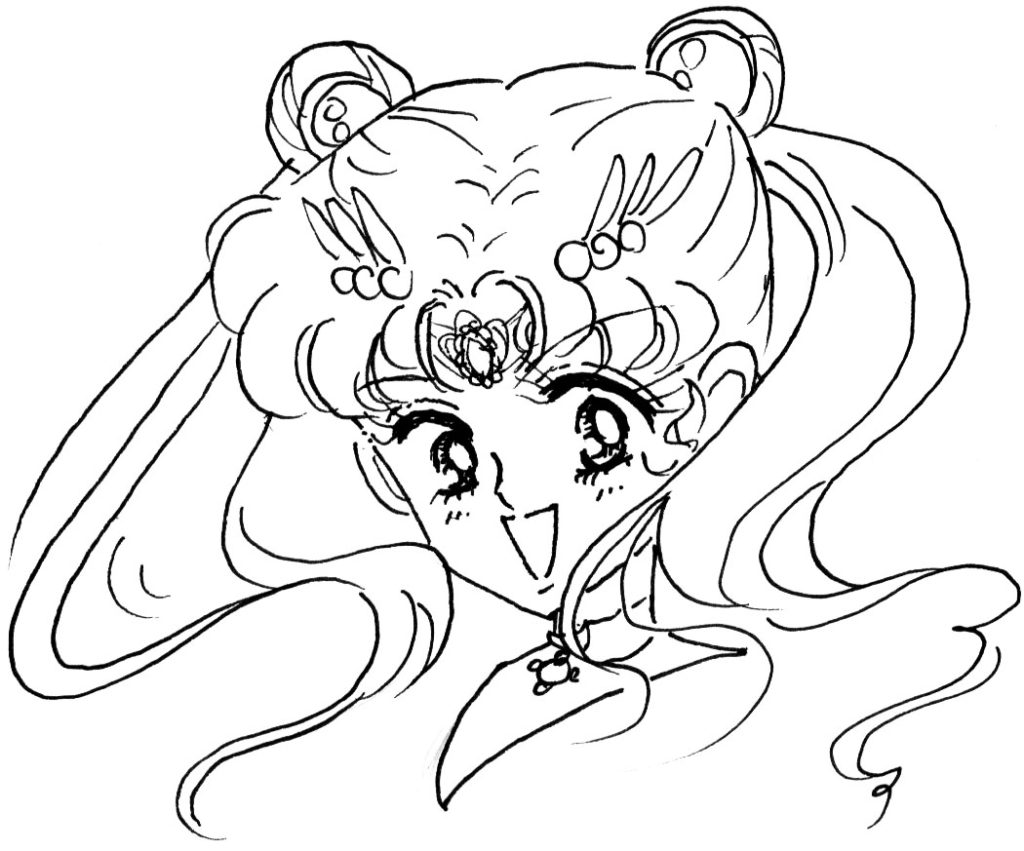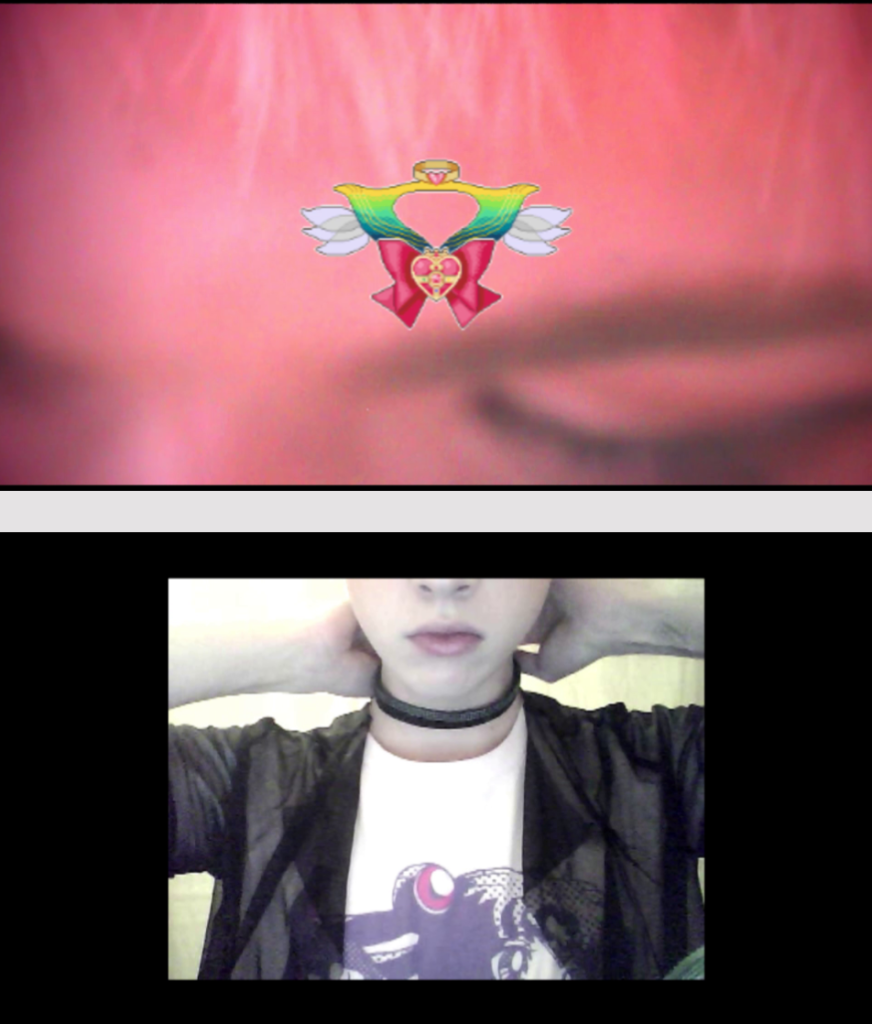Japanese anime and manga have been acknowledged internationally for crossing over nations and cultures. They are accepted in different ways depending on the context in which they appear. In some cases, Japanese anime and manga are highly appreciated as exceeding the range of subculture, and sometimes they are perceived as plain trash. In this context, Multiple Spirits wanted to consider manga and anime from a queer and feminist perspective.
The following interview is a conversation between Rosa Wiesauer, who is working as an artist focused on queer and feminist subjects, based in Vienna and Mai Endo, a Japanese performance artist challenging how feminism is being portrayed in Japan. Both have been influenced by Japanese manga and anime as well as fashion culture since their childhood, and this influence leads them their practices as artists. The interview was held at cafe Lazy life which hosts art events and talks. Endo and Wiesauer have broad knowledge about manga and anime. They spoke about how this culture has been accepted in different contexts, and it’s a relationship with other fields such as art and fashion.
In times where the Internet allows cultures to spread so easily worldwide, this interview might bring us to questions of what kind of possibilities manga and anime have, how this culture has been alienated and what the main differences can be depending on reception and position. (Updated on March 23, 2023)
Endo Mai (M): I heard that one of your favorite manga is Paradise Kiss. How did you get to know this?
Rosa Wiesauer (R): I don’t remember exactly, but I was around 13 years old. One of my friends, she is Chinese and was drawing a lot of anime and manga characters. We were both interested in manga and anime. One day she brought Paradise Kiss to school, and I was very much into it. She borrowed me the manga, and I read it in no time. Paradise Kiss has also evened out the path I chose to go in the end. I finally decided to go to fashion school because of the apparently fascinating life as a fashion designer/fashion design student and model in this manga. In Austria, when you’re 13-14 years old, you need to choose which school you are going to attend at a secondary level. So you already need to make up your mind and take a decision about what profession you want to learn.

M: So, you made this decision at the early stage of your life. In Japan, we could make this kind of choice around at the age of 15 when we finish junior high school. In Paradise Kiss, the main
R: I knew that the manga appeared in Zipper. At that time, I already downloaded Japanese magazines online, looking for pictures and art books. There were a lot of fan pages of Ai Yazawa, and they scanned books. Also, the author wrote some background information on columns on the side of the manga, and I learned that it was in Zipper. Everything was translated into German.
M: I see. Have you also read Neighborhood Story?
R: In the German-speaking context, NANA came first, and Neighborhood Story was translated after a few volumes of NANA. I really like the aesthetics of Neighborhood Story with the 80s and the 90s style. Also, it was amazing that all characters were deeply characterized, and they have own personalities. I love how they work together as a community and
M: In Japan, there was a strong liking between manga and fashion, like Zipper, in the 2000s. When I was a child, I thought the fashion appearing in
R: I also used to download patterns of Lolita clothing items back then.
M: There were many amateur models who appeared in fashion magazines, and each of my friends admired different amateur models.
R: The pop singer, KYARY PAMYUPAMYU, used to be an amateur model too. The good thing about Tokyo Fashion is that they were actually scouting real persons, not just models. I also liked the magazine KERA which showed different ways of coordinating Lolita brands with other styles. It was really exciting.
M: In 2006, there was the manga Real Cloth, which is a kind of Japanese version of The Devil Wears Prada. At that time, fast fashion like H&M was blooming in Japan, and its protagonist was a buyer of a department store. It was about how the department store could survive in comparison with fast fashion.
R: I’ve also read some articles about how street fashion culture in Harajuku suffers from the effects of fast fashion. I feel like nowadays everyone seems to be wearing the same clothes. Compared to a few years ago, there used to be more variety in styles. Recently even Lolita Brands have closed down their stores or even the brand as a whole.
M: I think the fashion trend gradually turned to

R: By staying up to date with Japanese fashion magazines and blogs, we can observe how quickly trends evolve and disappear. Throughout the 2000s and even earlier Gyaru culture and
How do you perceive “genderless” in fashion?
R: I read an article about “genderless” on tokyofashion.com featuring people like RYUCHELL or Pee. A lot of my friends told me “Omg, this is what you’ve been doing for years and now it has become a trend!” I think it’s great that the trend has been involved in this direction. However, my impression is that everything in Japanese pop-culture is inherently superficial. It’s all fantasy just happening on the surface and not about living a certain kind of way. But compared to fashion in Europe, at least people in Japan don’t seem to judge or threaten people who wear “genderless” fashion.
There has been a trend called Dansou, where women wear mostly men’s clothing and style accordingly. I have been to several European Lolita fashion events including a tea party in Amsterdam. I met Akira, a boy-style Lolita model, there. When I was smoking outside, she came, and my friend and I asked to take a selfie with her after which she asked me with a shocked expression: “You’re not a woman?” Akira was shocked after finding out I was not a cis-woman. Later that day I overheard her talking to her translator about me “Is that girl a man?” I was completely irritated that the model wearing boy-style had no acceptance or knowledge about non-binary or transgender identities. To her, it seems to be just a costume that is being put on. I mean there are a lot of characters in manga and anime that embody trans or non-binary identities, but at the same time, in reality, trans people are dismissed from family or can’t find any job or whatsoever in Japan. It is like being trans is ok as long as you are being watched from a distance or in the entertainment industry on a screen, magazine or stage. But there seems to be no tolerance for a living human being who is neither female nor male.
Differences in Receptions of Aesthetics of Manga and Anime
R: For example, the characters appeared in Paradise Kiss were basically minorities in society. They couldn’t go through a “normal” path, and therefore they made a community and a fashion brand by themselves. The readers are into the story while feeling sympathy how the characters realize their dream as well as incompatibilities with “ordinary”. However, the culture in Tokyo depicted in the manga seemed to be unrealistic to me who grew up in the countryside where school rules were strict. I couldn’t have a variety of choices of what I could wear. Therefore, I couldn’t connect the world in the manga to my reality. I think many people are thinking like this. More than that, other mangas, like Boys Over Flowers or Peach Girl, which are set at an ordinary high school, seemed more realistic to me. They showed realities of high schools such as bullying, failures to obey school regulations, or troublemakers. But, these mangas are based on the heterosexual norm, especially the romance between a hot boy and a girl as the main protagonist. Once, I also used to be a Lolita, and I felt that wearing Lolita fashion itself made people keep away from me, and it was a kind of armor.
R: That seems like how being a drag queen used to be a coping mechanism or a form of
M: I think there
R: What we can do is to take all the feminist perspectives from existing anime and manga, and take what we think is empowering to us. A movie which I saw was also quite empowering to me. Do you know a film Kamikaze Girls? Anna Tsuchiya was one of the actresses and also a model in Zipper.
M: She made her début as a neat and clean girl, but she switched her style to rock and punk.
R: But still, it’s only about fashion. Nothing else is seen critical of it, isn’t it? Lolita communities in a western context
M: When I wore Lolita fashion, I could do

R: Wearing Lolita means belonging to the community foremost through fashion. I think Gyaru was also considered more as a community. In Europe, when people in Lolita are being asked if they wear cosplays, this question is deemed to be rude. For European Lolitas, their outfit is not a costume but rather a political statement. I’m starting to write my diploma thesis about the queer feminist potential of Sailor Moon. It is perceived as empowering from a Western feminist perspective. I want to work on the differences between Western and Japanese perception. I’m wondering whether there is also a potential for empowerment in Sailor Moon in Japan. However, I’m conflicted about touching on subjects of cultural appropriation. But still it shows queer relationships as well as feminine power, and even queer family structure and trans characters. It’s interesting to me that I can take many things from it. But, in Japan, it seems to be different. M
M: When we watched Sailor Moon on TV, we believed that we could become one of the Sailor Soldiers. Although the main character is a crybaby and scatterbrain, she achieves big things that she cannot do by herself by cooperating with friends around her. Her friends have different abilities and personalities. I still believe that we can manage many things through cooperation between friends. But this is different from what the previous generation thinks. For instance, my mother thinks that “girl’s power” is something like a story which appeared in sports manga, such as Aim for the Ace! or Attack Number 1. This genre of sports manga shows stories in which a girl has to go through hard training mentally and physically to be a winner. In addition, the story has a structure that a manager (usually a man) finds her talent and trains her, and she can grow up depending on the manager. But, in Sailor Moon, there is only a man, Tuxedo Mask. He has a gentle manner, and he just throws a rose. At that time, there was a TV drama Ienaki ko (the child without a home), and therefore, there were many cases at schools that one girl was bullied by many girls as if they imitated the drama.
R: Do you think that there is no such thing as solidarity among women? That’s such a sad fact and it shows how women have also internalized misogyny.
M: I think there have been unities of friendship, but on the other hand, these unities have produced exclusion of certain person.

R: What I appreciate in Sailor Moon, although there are many things to be criticized about like heterosexual values as well as fatphobic body images, they showed a diversity of people. Michiru and Haruka can still exist in the same community, not being questioned about their sexuality. They have never been ridiculed. In the American version, the couple was even made as cousins due to heavy censorship. They were not in a romantic relationship. In addition, Sailor Starlights who transformed from male to female was never shown, and Kunzite was changed to a woman even though he was an effeminate gay man. It is very funny that they changed just a few small details that can be read as queer.
M: Oh, really? I didn’t know that. The author of the Sailor Moon, Naoko Takeuchi, likes figure skating and she adopted its aesthetic into the design of the manga. The skinny body probably came from this. When I watched Sailor Moon, I didn’t care about which kind of sexuality Haruka, because I still believed that a male could transform into a female and vice versa without any awareness of sexuality and gender. Later, when I had to wear the school uniform at junior high school, I became aware of it.
How Manga and Anime influence your art practices?
R: In my generation manga and anime were a big hit. When I was a child, a lot of anime, for example, Pokémon, Sailor Moon as well as DRAGON BALL were shown on TV. There was also big hype of anime and manga drawing. Almost everyone my age was watching anime at that time. Some people also started reading the manga. Through this, some developed their interest in Japanese pop culture. I don’t know how it is nowadays. There’s not much shown on TV anymore. We used to have ORF, the Austria National TV program and RTL2, a German program that showed anime in the afternoon from the late 1990s to the 2000s.
But still, reading manga was ridiculed when I was a teenager. I remember that when I was applying for a fine art high school, they didn’t want to accept manga drawing, because there was such hype of manga and anime and people didn’t take it seriously or consider it valuable. “It’s not art, and we don’t want to see that”. I even think the rejection of manga and anime aesthetics in the field of fine arts has to do with classist discrimination. In the university, I still feel that they don’t want to see these kinds of subcultural images. That’s why it took me some time to show my appreciation of anime and manga and interest in Japanese pop culture openly. Especially the first two years in the university, being interested in Japanese pop culture and studying art were two separate things. Why should I deny what I grew up with? Why should I not be influenced by it? I’m happy that it is possible now for me.
M: Same in Japan. Sometimes, “it looks like manga” is used to
R: When I was in fashion school, my designs were called out as being too influenced by anime and manga. I really tried to deny that and get away from that aesthetic. At the same time, it’s ridiculous how fashion drawing also idealizes and fantasizes about the female body with heavily distorted images. These fashion drawings were ok and welcome, but manga eyes were not ok?
M: Also, my art teacher at the elementary school asked me to change my eyes I drew in my portrait because, she said, big eyes looked like manga. I felt ashamed because she told me that we should not
R: Japanese pop-culture has definitely influenced my artistic practice, too. I used to use the aesthetic when I was performing as a drag queen and also in some of my self-portraits. My most recent work deals with the genre of Mahou Shoujo – Magical Girls. I use the term magical girl as synonymous for my non-binary and trans*feminine identity. However, it is still always a thin line for me between appreciation and appropriation that I find so interesting and challenging. I’ve been dealing with Japanese pop-culture for years. Bringing together queer and feminist theories with Japanese pop-culture is very exciting for me.

M: I think there is also influences on my way of thinking and values. For example, I learned the planet system and its corresponding guardian deities as well as previous life and reincarnation from Sailor Moon. Recently I got interested in minerals because the manga the Kingdom of Jewellery shows characters with a personality of each actual mineral. However, it was too natural to read manga and watch anime in my adolescence, therefore it was difficult to distance from them, and even I didn’t know I liked them or not. As I grew up in changing environments, I finally realised that they have influenced me. In my art practice, it is more important to distinguish these influences.
*The interview originally appeared in Multiple Spirits vol.1, and it was edited for online. Courtesy of the authors.